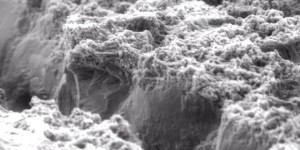
Just a short post about bacteria literally converting the built environment into the natural environment. There are numerous specialized bacteria currently eating the Titanic, including one called Halomonas titanicae. They’re converting the steel and iron into rust and the whole thing may be gone in a few decades.
Bad news for history buffs, good news for all the other metal junk we toss in the ocean.
Steel exposed to the “elements” will rust – or be consumed by bacteria. The Golden Gate Bridge has been under continuous re-painting since it opened 75 years go in order to protect the steel from such deterioration that could threaten its structural integrity.
But if it weren’t protected and it collapsed into the Bay, would it be “natural?” After all, the steel did not get fabricated and located across the Golden Gate through natural processes.
Jonathan’s post makes me wonder what is the “natural environment.” To what extent does human intervention count as a part of natural processes? Is a grassy plane landscape that was forested before the arrival of humans count as a “natural environment?” Is a forest planted by Johnny Appleseed a “natural environment?” What about buildings built by re-arranging natural materials (such as rocks or earth) without altering their fundamental character or even structures built into the side of a hill or a human-made cave?
Buildings’ metallic components exposed to the environment are subject to rust, especially when moisture is present. What is normally considered “rust” or “corrosion” absent the detailed science done on the Titanic may be bacterial and/or “rust.” (“Rust is a general term for describing iron oxides. In colloquial usage, the term is applied to red oxides, formed by the reaction of iron and oxygen in the presence of water or air moisture.” – Wikipedia: “rust”).
But of truly great significance for us (humans) are the forces that result in deterioration of structural components of a building (such as steel columns, beams or girders) or reinforcing steel.
When steel is protected from the forces of “nature” (water, acidic aerosols, or many other components of air), it will deteriorate. If that happens to be a reinforcing steel rod in a structurally important reinforced concrete beam, that could threaten the integrity of the structure and the health of the building.
Buildings, bridges, towers (and many other structures) are susceptible to a variety of forces in nature, not only rust or bacterial transformation, but also the forces of wind and seismic movement of the earth.
The distinction of a “natural” versus a “built” environment is, from a microbial viewpoint, an artificial one based on a humanocentric perspective. Microbes will fill any available eco-niche regardless of its origin, and don’t distinguish between a substrate in its “natural” form – eg. in situ mineral deposits – or its processed form – steel. One point this article raises for me is one I’ve wondered often about the audience of this forum – if they are aware of the large body of literature and the history of science’s involvement in the interaction of microbes with “built” environments. This involvement has most often taken the form of the development and implementation of microbial control technologies. Billions of dollars are spent every year in attempts to eliminate or mitigate the impact of microbes on “built” structures such as cooling towers and pipelines, on industrial processes ranging from the mineral extraction industries to polymer production to papermaking, and on everyday products including shampoo and cosmetics. The microbiologists involved in this enterprise are essentially industrial microbial ecologists and have produced a large body of work relevant to the theme of “built” environments, and this is an effort that has been ongoing probably since Ignatz Semmelweiss discovered handwashing. Groups such as the International Biodeterioration and Biodegradation Society and the International Biodeterioration Research Group and their journals are useful starting places for those who wish to explore this topic. There is a large amount of literature available for those who wish to not spend time re-inventing the wheel, or concepts, and some very interesting (and fun) history, aspects and applications of science to discover.
Well, first – Hal – this is not my post -it is David Coil’s.
Second – John – thanks for the detail / information on others working on issues relating to microbiology of the built environment. I will look into that in more detail.
Third – I think the distinction between “natural” and “built” environment is complicated at best and clearly anthropocentric. Perhaps in the long run a better way to think about this distinction, if there is any, is really the issue of pre-industrialization vs. post. Or pre-massive-human-impact-on the planet vs. post. The human BE can be viewed as a largely relatively new environment and thus the ecology of this environment is more akin to the ecology of say a volcanic island popping up out of the ocean. Or perhaps the ecology on meteors after they have landed on Earth. Or something like that.
Jonathan – I like your response to my comment on David’s post! thanks, – hal